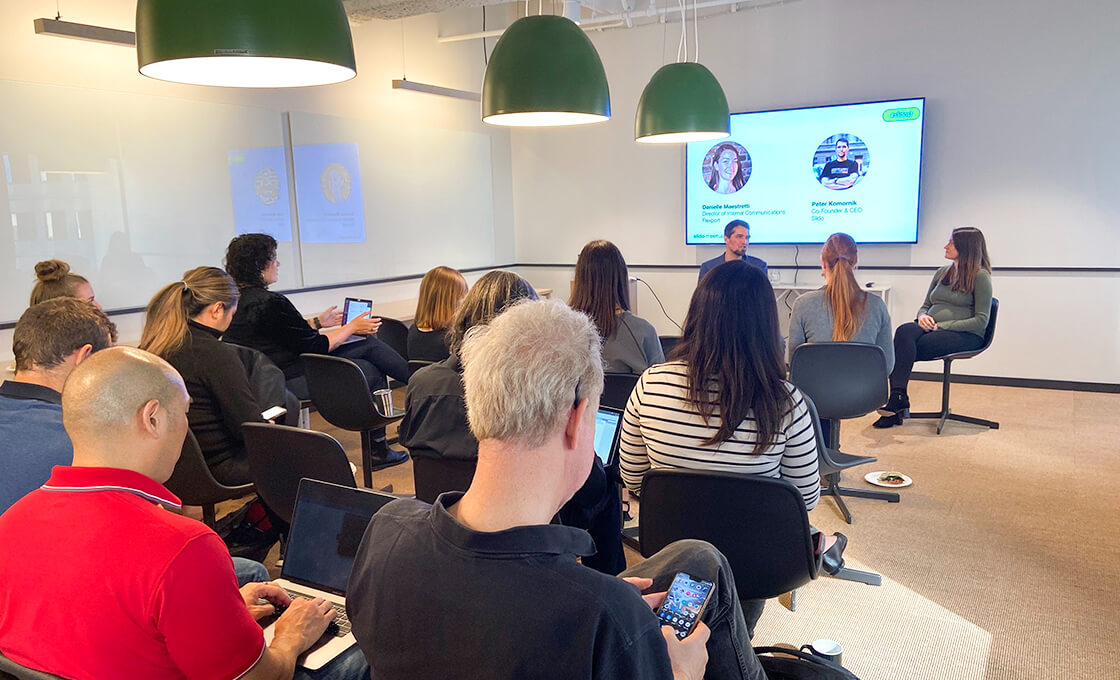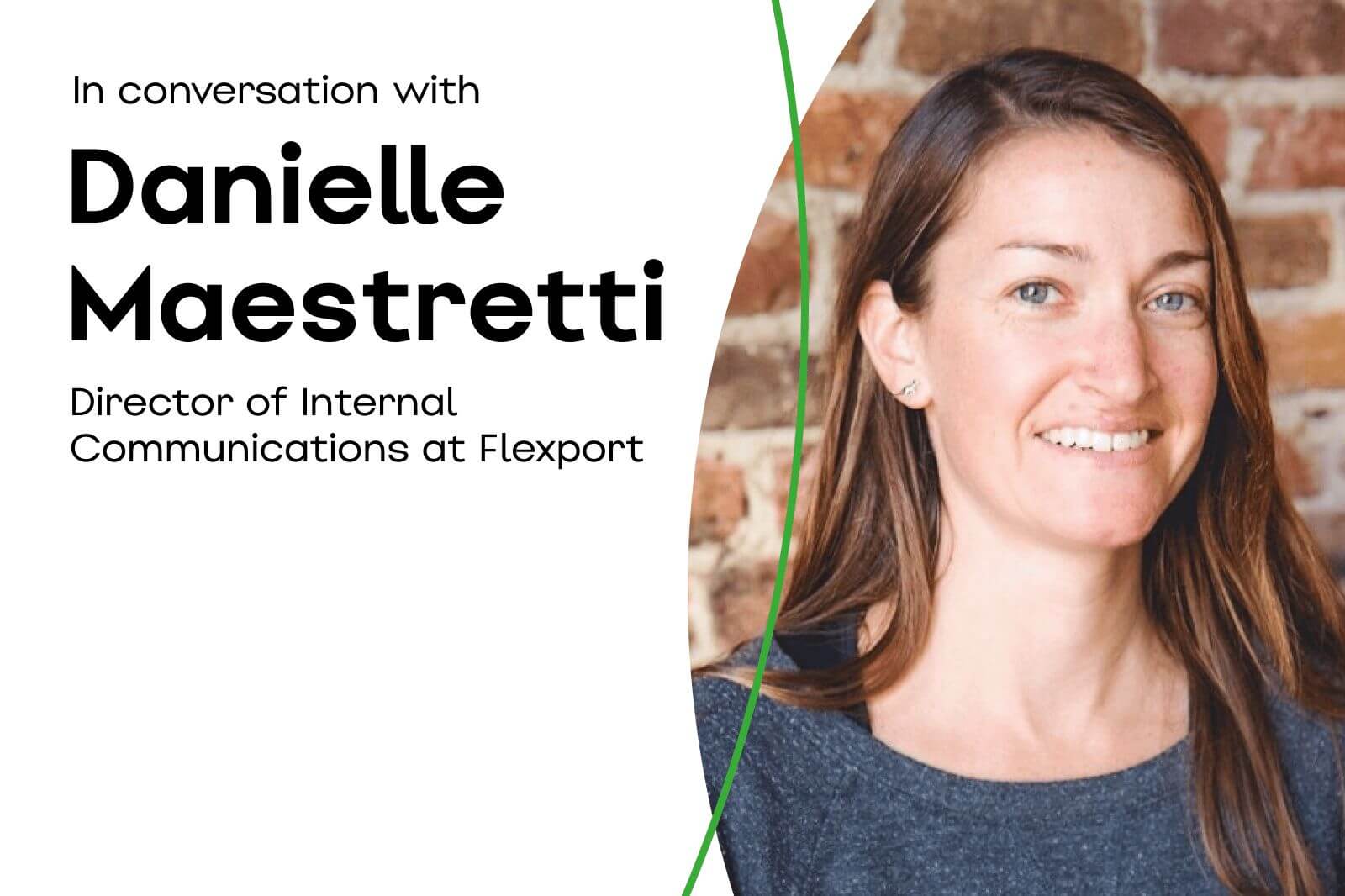Flexport is a freight forwarding platform that helps users move, finance and make better decisions about their freight. In layman’s terms, their daily bread is helping people ship a huge number of goods from point A to point B without a glitch.
At first glance, freight forwarding might not strike one as a particularly sexy industry.
In fact, TechCrunch has labeled Flexport ‘the unsexiest trillion-dollar startup’.
But their impressive hyper-growth and continuous global expansion keep the whole Silicon Valley in awe.
Danielle Maestretti, who’s Flexport’s Director of Internal Communications, has been part of their amazing journey from the early years.
She joined the company in 2016 when the team was made up of 120 people. Now, they’re pushing 1,800 and run 16 offices around the world.
Naturally, growth this big doesn’t come without a challenge. How do you effectively communicate and make sense of your company values in the face of such rapid growth?
We were eager to know. Our CEO, Peter Komornik, sat down with Danielle at our recent user meetup in San Francisco to find out.
Read more in this insightful interview:
Q: Your team is now 15 times bigger than when you joined the company. What were some of your biggest challenges that you had to deal with in Internal Comms?
There are so many. It’s actually quite hard to say how much of it is on account of the rapid global expansion and how much is just the headcount growth. I joined the company in the time when everybody knew everybody and it was easy to feel like a family.
Today, it’s easier for our employees to feel like they’re losing touch with each other. In particular, people outside our San Francisco offices sometimes feel distant from decision-making processes.
We also have a really complex organizational structure. One of the reasons we launched an intranet was actually to help people to answer questions like “Who is that person and where do they fit in the org?” or “Where do I fit in the org?”
It gradually became more difficult to distribute information and communicate effectively. It’s just a lot more people to align and check in on. That’s what makes Internal Comms important.
Q: So how do you manage to keep people aligned?
Our company’s value proposition is built around transparency and visibility to our customers and that really reflects internally too.
Personal relationships go a long way. It’s about going in and asking people “What are your challenges?” or “What can we help you with?” and genuinely listening. That’s the strongest way. We do a lot of Zoom calls with people outside of the HQ.
We share all the important updates together with photos from each office in a bi-weekly newsletter and we run what we call ‘Open Houses.’ These are sessions where teams share details about key initiatives and projects they’re working on and answer questions; they’re open to anyone who is interested. We run Open Houses once or twice per month. They’re voluntary to attend and always recorded.
On top of all that, we have our monthly all-hands meetings. We’re rotating times for our all-hands or hosting them live from different regions. We record every meeting. We try and make sure that everybody feels included.

Q: I know that all-hands meetings are very important for you at Flexport. How do you structure them?
Our all-hands mean a lot to us. They are very expensive meetings because everyone attends, and there’s a lot at stake. We run our all-hands monthly.
Today, we’ve got a very predictable format. Our CEO gets 10 minutes. He usually talks about some current issue that’s going on in the company and how that ties to Flexport’s mission and values. We always have a guest host. Then we do what I call ‘timely’ content. That is basically business updates presented by teams that have either some cool product news to share or a new business initiative that deserves to be in the spotlight.
Our CEO also spends time at every all-hands to show examples of situations in which our people translated our values into practice, and gives a shout-out to them. This helps us to reinforce our values, clear up what they mean and foster recognition.
We’re currently undergoing a values refresh project with our CEO, so this will continue to be important.
Q: That sounds amazing. What’s the project about?
We started to see very clearly that while people like our values, they don’t really know what they mean in practice. And we don’t want our values to become just posters on the wall.
That’s why we’re looking for ways to educate people on what our values mean, how to act on them and what is a good example of demonstrating them.
A great example is ‘practice candor,’ one of our core values. Some people might interpret it as a license to be rude, in the name of being honest or straightforward, but the intention behind it is to listen and approach with empathy.
Q: What role does leadership play in the project and in Internal Communications in general?
Our leadership is essential for our communication. I’m lucky that the company and the executives take internal comms seriously. They generally have a reflex of talking to us first before sending out a global communication via email or intranet.
I’m fortunate that our CEO, Ryan Petersen, is a very prolific and good writer. He often sends me essays that he’s written and then we publish it for the whole company. In these, he talks about everything from our values, culture, and business, to the importance of planning and how what we’re doing maps to our strategy and our goals.
He’s also very keen on answering questions during our all-hands meetings. We always dedicate 15 minutes of the all-hands to Q&A with the entire executive team. We’re pretty strict about keeping it to at least 15 minutes. Our CEO doesn’t shy away from answering any questions, he sees great value in having a candid Q&A.
Q: Can you tell us a bit more about how you run your Q&A sessions?
Sure. We use Slido to collect questions ahead of every one of our all-hands meetings. We’re actually not taking any questions from the room during our all-hands — this gives everyone in all of our offices, whether they’re attending live or not, an equal chance to ask their questions.
We started doing this because with teams scattered around the world, with some of them being able to watch the all-hands meetings from a recording only, we didn’t want to favor those sitting in the room in San Francisco. So whatever the time zone our people are in, they can submit their questions ahead of time and then watch the recording and see the answers.
Slido has been a huge game-changer for us. That’s why we bought so many licenses because as soon as we started using Slido, we got leaders from every department saying: I want Slido for my meetings too.
Q: What do you think is the biggest value in running those Q&A sessions?
Q&A sessions give everybody this opportunity to connect with the
leadership team. We also have an ongoing AMA Slack channel where anybody can ask questions of the executive team. Here the questions are a bit more casual.
But running a Q&A at the all-hands is different. The questions tend to be more on-point, more relevant to everybody. We don’t allow anonymous questions; people post their questions in Slido and really take the time to think about them.
I think it’s about the connection and the feeling like everybody has the ability to ask some real burning questions and get real answers on the spot from our leaders.
Thank you so much, Danielle.




